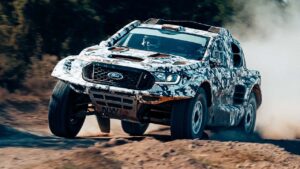Blue Oval adjusts car priorities based on consumer demand.
Ford recently revealed plans for alterations to the production quantities of its Bronco, Ranger, and F-150 Lightning models. Due to high demand for the Bronco, Ranger, and their Raptor versions, the Blue Oval has implemented a third production shift at their Michigan Assembly Plant in order to meet this demand. This arrangement is expected to continue for the foreseeable future.
By taking this action, the Dearborn-based company has generated approximately 900 fresh positions. This means that the newly implemented third shift requires a workforce of 1,600 individuals. The other 700 employees are comprised of current Ford staff from the Ford Rouge Complex.
In the upcoming months, Ford is set to implement further modifications in order to facilitate a rise in production for the Ranger and Bronco. Eventually, all three shifts at the Michigan Assembly Plant will work seven days a week to produce these vehicles.



Despite the positive outlook for the company’s future, the highly-anticipated F-150 Lightning presents a contrasting narrative. Ford recently revealed plans to reduce the production of electric trucks, as the Rouge Electric Vehicle Center is set to decrease its operations to just one shift starting April 1.
In October, it was reported that Ford was decreasing its production in response to declining demand. Despite Ford’s assertion that the Lightning is the top-selling electric pickup in America, it cannot be ignored that sales dropped by 45.8% in the third quarter of 2023. This is a significant change from when Ford had to increase production of the F-150 Lightning.
Due to this, about 700 workers will be reassigned to the Michigan Assembly Plant, while the rest will be assigned to various positions at the Rouge Complex or transferred to Ford-owned facilities in Southeast Michigan. According to the company’s statement, some individuals may also opt for the Special Retirement Incentive Program outlined in the 2023 Ford-UAW agreement.



According to CEO Jim Farley, Ford is utilizing its “manufacturing flexibility” in order to provide customers with options while also maintaining a balance between growth and profitability. He further stated, “We have a positive outlook for electric vehicles, particularly for certain consumers, as we prepare to launch our technologically advanced EVs and begin utilizing Tesla’s charging network starting this quarter.”
In a recent statement, Ford revealed that it incurred a loss of $36,000 for each electric vehicle sold in the previous year. The company acknowledged that a significant number of consumers are not willing to pay extra for electric vehicles. Despite this, Ford’s Chief Financial Officer, John Lawler, clarified that this does not indicate a lack of growth in the segment. He stated, “There is a prevailing belief that EVs are not experiencing growth, but this is not true. In fact, they are growing; just at a slower rate compared to the overall industry, which is in line with our projections.”
Car dealerships are facing issues when it comes to selling electric vehicles (EVs), which has led some car manufacturers to reconsider their EV strategies in favor of a more diverse approach.Despite the growing interest and demand for environmentally-friendly vehicles, many dealerships are struggling to close deals on EVs. This has forced automakers to reassess their plans and come up with new strategies to boost sales.One possible reason for this struggle is the lack of knowledge and understanding about EVs among potential customers. Many people still have concerns about the limited mileage range and long charging times associated with EVs. As a result, they may be hesitant to make the switch from traditional gas-powered cars.To combat these challenges, some automakers are now adopting a more diverse approach to their EV lineups. Instead of solely focusing on pure electric models, they are also offering hybrid vehicles, which combine both an electric motor and a traditional gasoline engine. This gives customers the option to choose a vehicle that suits their needs and preferences.In addition, some car manufacturers are also investing in improving the charging infrastructure for EVs. This will make it easier for customers to charge their vehicles on-the-go, addressing one of the major concerns about EVs.Overall, the shift towards a more varied approach to EV
According to Ford, they will now provide “the right blend” of gasoline-powered hybrids and electric vehicles, with a focus on profitability. It seems that Toyota had the correct strategy for incorporating electrification from the beginning.









I completely agree with your points. Well said!